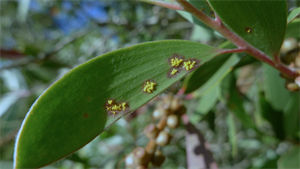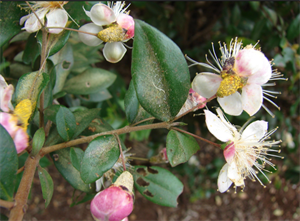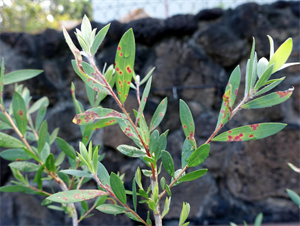Myrtle rust. It has other names based on the hosts infected, e.g., guava rust, eucalyptus rust, ohi'a rust.
Pacific Pests, Pathogens and Weeds - Online edition
Pacific Pests, Pathogens & Weeds
Myrtle rust (476)
Austropuccinia psidii; previous names are Puccina psidii, and Uredo rangelii. There are several strains or races that show different reactions on a range of host plants.
Asia, Africa (restricted), North, South and Central America, the Caribbean, Oceania. In is recorded from Australia, New Caledonia, and New Zealand.
Nearly 350 species are known to be natural hosts in the Mytaceae family, and many more have been found to be hosts in lab tests. The Mytaceae family includes allspice, bottlebrushes (Callistermon), clove, Eucalyptus, guava, lilly pilly (Syzygium), paperbarks (Melaleuuca), and tea tree (Leptospermum).
A serious fungal disease of the Myrtaceae infecting young actively-growing plant parts; severity of symptoms depends on host species. Commonly, infection results in spots producing masses of spores, distorted growth, defoliation and branch dieback, stunting and shrub-like appearance when terminal buds are destroyed, and death of susceptible species.
First signs of infection are small purplish specks on young leaves, shoots, flowers and fruits; these turn into pustules (uredinia), 0.1-0.5 mm diameter, producing bright yellow masses of powdery spores (urediniospores) after a few days, surrounded by a purple ring (Photos 1-3). These spores are produced asexually. The pustules enlarge, merge, eventually fading to dull yellow, then greyish-brown (Photo 4).
From within the uredinia, on the undersurface of leaves, another spore-forming structures may develop, the yellowish-brown telia, producing teliospores. They are the thicker walled 'survival' spores produced by many rusts. In turn, the teliospores germinate to produce another spore type, the basidiospores, and these develop by sexual reproduction, which means they could produce new strains.
However, the importance of the teliospores and hence the basidiospores of myrtle rust is not yet understood; it awaits proof that basidiospores infect species of Myrtaceae, to complete the life cycle, either on the same host or on another that is yet to be discovered?
Whatever the answer, the urediniospores are the most important spores in the spread of the rust. The conditions are such in Australia that the rust can maintain itself using only urediniospores. Germination of urediniospores depends on temperature (15-25oC), leaf wetness (6 hours or more), and darkness (at least 8 hours). Spores can remain alive for up to 3 months.
Spread over short and long distances is by wind, rain splash, on clothing and personal effects, and vehicles. Animals (including insects and birds) can transport the spores. Spread can also occur associated with the domestic and international trade in timber, wood packaging and live plants; in the case of live plants, spread is assisted by the lack of symptoms for up to a month after infection.
The rust has spread quickly in countries where introduced, and CABI records major impacts on a range of trees in the Myrtaceae family - trees used as features in urban areas (home, botanic gardens, parks and street plantings), commercial plantations and native environments. There have been major effects on agriculture, too, such as that on allspice in Jamaica in the 1930s. More recently, serious impacts are reported on native forests in Australia following the introduction of the rust in 2010. Sensitive species have been killed by loss of leaves, dieback, or a failure to regenerate due to death of seedlings. These are likely to have serious knock-on effects on associated flora and fauna.
Specifically, there is cause for concern because of dieback on lilly pilly (Syzygium), paperbarks (Melaleuca), box brush (Lophostermon) and tea trees (Leptospermum). Two of the indigenous trees most under threat in Australia are the native guava (Rhodomyrtus psidioides), and scrub turpentine (Rhodamnia rubescens). In Brazil, economic damage to eucalyptus plantations is a major problem, and in Hawaii there is a threat to ohi'a (Metrosideros polymorpha), a dominant native tree, important to native Hawaiian ecosystems.
Look for yellow pustules on leaves, stems, flowers and fruits; darker pustules with teliospores may also be present on the undersurface of leaves.
BIOSECURITY
Countries still free from myrtle rust should take all practical precautions to prevent its introduction and further spread. Practical measures might include quarantines on plant and seed introductions of species susceptible to the disease from countries where it occurs. Regulations should also take note of the presence of strains of the rust, such as those affecting eucalyptus in Brazil which are as yet not well distributed. However, the difficulty of preventing further spread should not be underestimated as both Australia and New Zealand had quarantines in place, but introductions of the rust still occurred. There is still the possibility of movement of spores on contaminated plants not regulated, movement of people, and long-distant travel of spores on air currents to consider.
CULTURAL CONTROL
Limit spread of myrtle rust in home gardens and from nurseries:
- Check that plants, bought for home gardens, or moved as part of the trade in horticultural or forestry plants, are free of signs of myrtle rust infection.
- Avoid moving infected plants to areas where the disease is not yet established.
- Avoid replanting species which are severely affected by myrtle rust in home gardens, amenity areas, or native reserves.
- Consider removing (and carefully discarding) any plants with major infections from home gardens.
- Under no circumstances should nurseries maintain or keep for sale plants infected with myrtle rust.
Hygiene methods when working in home gardens, nurseries, bushland areas:
- Ensure clothing, equipment (tools, gloves) and vehicles are free of spores and plant debris. Wash clothing, and wash down vehicles after use in home gardens, nurseries or infected bushland areas,
- Do not travel from infected to non-infected areas, if possible.
- Remove infested plants carefully, preferably in plastic bags or containers; dispose of infected plants on site by burying or take wrapped (or in a closed vehicle) to a waste disposal site (not a green waste site).
- If infested plants are to be removed, consider spraying with a fungicide 1-2 days beforehand (see approved fungicides below).
CHEMICAL CONTROL
A number of fungicides are registered for use against myrtle rust in Australia: azoxystrobin; azoxystrobin/cyproconazole; tebuconazole; triadimenol; trifloxystrobin/tebuconazole. Copper fungicides and mancozeb are also likely to be effective. Rotations of strobilurin and sterol inhibitor fungicides are necessary to avoid resistance in rust populations. Follow manufacturers' instructions.
____________________
When using a pesticide, always wear protective clothing and follow the instructions on the product label, such as dosage, timing of application, and pre-harvest interval. Recommendations will vary with the crop and system of cultivation. Expert advice on the most appropriate pesticides to use should always be sought from local agricultural authorities.
AUTHOR Grahame Jackson
Information from Myrtle rust (2015) Prime Fact. Department of Primary Industries. NSW Government. (https://www.dpi.nsw.gov.au/__data/assets/pdf_file/0011/573707/primefact-myrtle-rust.pdf); and Myrtle rust (undated) Department of Primary Industries. NSW, Australia. (https://www.dpi.nsw.gov.au/biosecurity/plant/insect-pests-and-plant-diseases/myrtle-rust); and Myrtle rust (2019) Business Queensland. Queensland Government. (https://www.business.qld.gov.au/industries/farms-fishing-forestry/agriculture/crop-growing/priority-pest-disease/myrtle-rust); and Invasive Species Council (undated) Environmental impacts of myrtle rust. (https://invasives.org.au/wp-content/uploads/2014/02/fs_myrtle_rust.pdf); and from CABI (2019) Austropuccinia psidii (myrtle rust). Crop Protection Compendium. (https://www.cabi.org/cpc/datasheet/45846). Photo 1 John Tann Myrtle rust on broad-leaves paperbark. Photos 2&4 Scott Nelson Paperbark tree: Myrtle rust. Photo 3 Forrest & Kim Starr, Starr Environmental. (File:Starr 080326-3705 Myrtus communis.jpg).
Produced with support from the Australian Centre for International Agricultural Research under project HORT/2016/185: Responding to emerging pest and disease threats to horticulture in the Pacific islands, implemented by the University of Queensland and the Secretariat of the Pacific Community.







